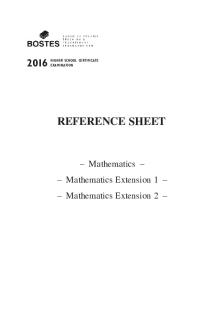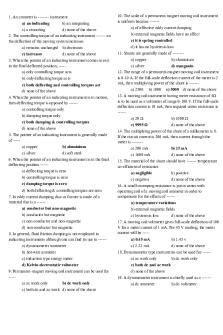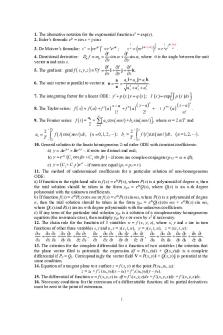Formula sheet for electrical engineering PDF

| Title | Formula sheet for electrical engineering |
|---|---|
| Course | Electrical Engineering |
| Institution | Charles Darwin University |
| Pages | 4 |
| File Size | 190.1 KB |
| File Type | |
| Total Downloads | 93 |
| Total Views | 159 |
Summary
Formula sheet for electrical engineering...
Description
2016
HIGHER SCHOOL CERTIFICATE EXAMINATION
REFERENCE SHEET
– Mathematics – – Mathematics Extension 1 – – Mathematics Extension 2 –
Mathematics Factorisation
Distance between two points
( )( ) = ( a + b )(a 2 − ab + b 2 ) = ( a − b ) (a 2 + ab + b 2 )
a2 − b2 = a + b a − b a 3 + b3 a 3 − b3
( x2 − x1 )2 + ( y2 − y1) 2
d=
Perpendicular distance of a point from a line
ax1 + by1 + c
d=
a2 + b 2
Angle sum of a polygon
S = ( n − 2) × 180°
Slope (gradient) of a line
y2 − y1 x 2 − x1
m= Equation of a circle
( x − h)2 + ( y − k) 2 = r 2
Point-gradient form of the equation of a line
y − y1 = m( x − x1 ) Trigonometric ratios and identities
sin θ =
opposite side hypotenuse
cos θ =
adjacent side hypotenuse
tanθ =
opposite side adjacent side
1 sin θ 1 secθ = cosθ sin θ tan θ = cosθ cosθ cot θ = sin θ cosec θ =
sin2 θ + cos 2 θ = 1 Exact ratios
45°
Tn = a + ( n − 1)d Sum to n terms of an arithmetic series
Sn =
n [ 2a + (n − 1) d ] or 2
2
n (a + l) 2
nth term of a geometric series
Tn = ar n−1
3
Sn =
(
a rn − 1 r −1
)
or
Sn =
(
a 1−rn 1−r
1
45°
60° 1
1
Limiting sum of a geometric series
S= Sine rule
a 1−r
a b c = = sin A sin B sinC
Compound interest
Cosine rule
r ⎞n An = P ⎛ 1 + ⎝ 100 ⎠
c2 = a 2 + b 2 − 2ab cosC Area of a triangle
Area =
Sn =
Sum to n terms of a geometric series
30° 2
nth term of an arithmetic series
1 ab sin C 2 –2–
)
Mathematics (continued) Differentiation from first principles
Integrals
ƒ ′( x ) = lim
⌠ (ax + b )n+1 n dx = +C ⎮ ( ax + b ) a ( n + 1) ⌡
Derivatives
⌠ ax+b 1 dx = eax+b + C ⎮e a ⌡
ƒ (x + h) − ƒ (x ) h→0 h
If y = x n , then
dy = nx n−1 dx
If y = uv , then
dy dv du =u +v dx dx dx
If y =
dy u , then = v dx
v
du dv −u dx dx 2 v
If y = F (u ) , then
dy du = F ′( u ) dx dx
If y = e ƒ ( x ), then
dy = ƒ ′ (x ) e ƒ ( x ) dx
⌠ ƒ ′( x ) ⎮ ƒ ( x ) dx = ln ƒ ( x ) + C ⌡ ⌠ 1 ⎮ sin( ax + b) dx = − a cos (ax + b ) + C ⌡ ⌠ 1 ⎮ cos (ax + b ) dx = a sin ( ax + b ) + C ⌡ ⌠ 1 2 ⎮ sec (ax + b )dx = a tan ( ax + b ) + C ⌡ Trapezoidal rule (one application)
dy ƒ ′( x ) If y = log e ƒ (x ) = ln ƒ (x ) , then = dx ƒ (x ) If y = sin ƒ ( x ) , then
dy = ƒ ′( x) cos ƒ ( x ) dx
If y = cos ƒ ( x ) , then
dy = − ƒ ′ ( x ) sin ƒ ( x ) dx
If y = tan ƒ ( x ) , then
dy = ƒ ′( x ) sec2 ƒ ( x ) dx
b
⌠ b−a ⎮ ƒ ( x ) dx ≈ 2 ⎡⎣ ƒ (a ) + ƒ ( b )⎤⎦ ⌡a Simpson’s rule (one application) b
⌠ b−a⎡ ⎤ ⎛ a + b⎞ ⎮ ƒ ( x ) dx ≈ 6 ⎢ ƒ (a ) + 4 ƒ ⎝ 2 ⎠ + ƒ ( b ) ⎥ ⎦ ⎣ ⌡a
Logarithms – change of base Solution of a quadratic equation
x=
loga x =
logb x logb a
−b ± b 2 − 4ac 2a Angle measure
Sum and product of roots of a quadratic equation
α+β=−
b a
αβ =
c a
180° = p radians Length of an arc
l = rq Equation of a parabola
( x − h )2 = ± 4a( y− k)
Area of a sector
1 Area = r 2q 2 –3–
Mathematics Extension 1 Angle sum identities
Acceleration
sin (θ + f ) = sinθ cos f + cosθ sin f
d 2x dv d ⎛ 1 2⎞ dv = v = v 2 = dt dt dx dx ⎝ 2 ⎠
cos (θ + f) = cosθ cos f − sin θ sin f tanθ + tan f 1− tan θ tan f
tan (θ + f ) =
Simple harmonic motion
(
x = b + a cos nt + α
t formulae
(
x = −n 2 x − b !!
θ If t = tan , then 2 s inθ =
2t 1+ t 2
)
)
Further integrals
⌠ x 1 dx = sin −1 + C ⎮ 2 a ⌡ a − x2
1− t 2 1+ t 2 2t t anθ = 1− t 2 cos θ =
⌠ 1 x 1 dx = tan −1 + C ⎮ 2 2 a a ⌡a +x
General solution of trigonometric equations
sin θ = a ,
θ = n π + ( −1) n sin−1 a
cos θ = a,
θ = 2n π ± cos−1 a
Sum and product of roots of a cubic equation
tan θ = a,
θ = n π + tan−1 a
α + β+ γ = −
b a
αβ + αγ + βγ = Division of an interval in a given ratio
αβγ = −
⎛ m x 2 + nx1 my2 + ny1 ⎞ ⎜⎝ m + n , m + n ⎟⎠
c a
d a
Estimation of roots of a polynomial equation
Newton’s method
Parametric representation of a parabola
For x 2 = 4ay, x = 2at,
(
x 2 = x1 −
y = at2
ƒ ( x1 ) ƒ ′( x1 )
)
At 2at , at 2 , tangent: y = tx − at2
Binomial theorem
3
normal: x + ty = at + 2at
(
At ( x1 , y1 ) ,
a+b
)
n
n
=
⎛ n⎞ ∑ ⎜⎝ k ⎟⎠ a k bn−k = k =0
tangent: xx1 = 2a( y+ y1 ) 2a normal: y − y 1 = − ( x − x1) x1
(
)
(
Chord of contact from x0 , y0 : x x0 = 2a y + y0
) –4–
© 2015 Board of Studies, Teaching and Educational Standards NSW
n
⎛ n⎞
∑ ⎜⎝ k ⎟⎠ an−k b k k =0...
Similar Free PDFs

Engineering Formula Sheet
- 10 Pages

Engineering Formula Sheet
- 11 Pages

IED-Review Engineering Formula Sheet
- 10 Pages

Formula Sheet for Chemistry
- 1 Pages

Formula Sheet for final
- 4 Pages

Formula Sheet for ACCT2211
- 1 Pages

Formula Sheet - for exams
- 1 Pages

Formula Sheet for Geometry
- 2 Pages

Formula Sheet for Accounting
- 3 Pages
Popular Institutions
- Tinajero National High School - Annex
- Politeknik Caltex Riau
- Yokohama City University
- SGT University
- University of Al-Qadisiyah
- Divine Word College of Vigan
- Techniek College Rotterdam
- Universidade de Santiago
- Universiti Teknologi MARA Cawangan Johor Kampus Pasir Gudang
- Poltekkes Kemenkes Yogyakarta
- Baguio City National High School
- Colegio san marcos
- preparatoria uno
- Centro de Bachillerato Tecnológico Industrial y de Servicios No. 107
- Dalian Maritime University
- Quang Trung Secondary School
- Colegio Tecnológico en Informática
- Corporación Regional de Educación Superior
- Grupo CEDVA
- Dar Al Uloom University
- Centro de Estudios Preuniversitarios de la Universidad Nacional de Ingeniería
- 上智大学
- Aakash International School, Nuna Majara
- San Felipe Neri Catholic School
- Kang Chiao International School - New Taipei City
- Misamis Occidental National High School
- Institución Educativa Escuela Normal Juan Ladrilleros
- Kolehiyo ng Pantukan
- Batanes State College
- Instituto Continental
- Sekolah Menengah Kejuruan Kesehatan Kaltara (Tarakan)
- Colegio de La Inmaculada Concepcion - Cebu






